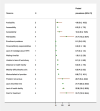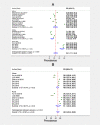A systematic review and meta-analysis of unmet needs for healthcare and long-term care among older people
- PMID: 36482044
- PMCID: PMC9733388
- DOI: 10.1186/s13561-022-00398-4
A systematic review and meta-analysis of unmet needs for healthcare and long-term care among older people
Abstract
Background: The absolute number of older individuals needing medical care and long-term care (LTC) is increasing globally due to the growing ageing population. However, it is uncertain who and what proportion of the population has access to care. Therefore, a systematic review and meta-analysis of the prevalence and reasons for unmet needs for healthcare and long-term care among older people, 65 years old and above, across countries was conducted.
Methods: An information specialist performed a comprehensive search of four major databases (PubMed, EMBASE, Web of Science, and CINAHL) from inception to June 2020 without restrictions on language and date. We did random-effects meta-analysis to obtain pooled prevalence. We stratified the meta-analysis by reasons for unmet need categorized by barrier dimension (availability, accessibility, affordability, and acceptability), survey year, geographic location, and socio-demographic characteristics of the older individual.
Results: After screening 3912 articles, we included 101 studies published between 1996 and 2020. Of the 101 studies, 87 studies reported unmet healthcare needs and 14 studies reported unmet LTC needs. Overall, 10.4% (95% CI, 7.3-13.9) of the older population had unmet needs for healthcare. The common reasons for unmet healthcare needs were cost of treatment, lack of health facilities, lack of/conflicting time, health problem not viewed as serious, and mistrust/fear of provider. A significant variation in pooled prevalence of unmet healthcare needs due to cost was found by gender (male [10.9, 95% CI, 8.9-13.1] vs female [14.4, 95% CI, 11.8-17.3]), educational level (primary or less [13.3, 95% CI, 9.6-17.6] vs higher [7.5, 95% CI, 5.9-9.3]), self-reported health (poor [23.2, 95% CI, 18.8-27.8] vs good [4.4, 95% CI, 3.4-5.5]), insurance status (insured [9.0, 95% CI, 7.5-10.6] vs uninsured [27.7, 95% CI, 24.0-31.5]), and economic status of population (poorest [28.2, 95% CI, 14.1-44.9] vs richest [7.1, 95% CI, 3.8-11.3]). One in four (25.1, 95% CI, 17.1-34.2) older people had unmet needs in LTC. Rural residents had a higher prevalence of unmet needs in LTC compared to their urban counterparts.
Conclusion: With the population ageing globally, it is necessary to improve access to health care and LTC for older people. Ensuring affordability of health services, reducing geographical barriers, and improving acceptability, will be critical in reducing unmet need. Unmet needs for healthcare were concentrated in population with no education, poor economic group, outpatient health facility user, and uninsured group. With education and economic-based inequalities at the forefront, all countries should focus on improving access to health services by reducing the burden related to healthcare costs.
Keywords: Barrier dimension; Long-term care; Md. Mizanur Rahman and Megumi Rosenberg are jointly first author.; Older population; Systematic review; Unmet need; meta-analysis.
© 2022. World Health Organization.
Conflict of interest statement
We declare no competing interests.
Figures
References
-
- Nations U. World population ageing 2017-highlights. New York: United Nations; 2017.
-
- Organization WH . Decade of healthy ageing: baseline report. 2020.
Grants and funding
LinkOut - more resources
Full Text Sources




